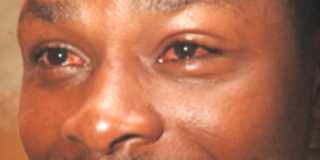Red eyes outbreak scares Kampala

A red eyes patient
The outbreak has spread in Kisenyi and been reported in Makindye. Red eyes can be prevented. However, when one of your family members gets it, seek medical care, writes Agnes K. Namaganda.
For Grace Nansamba who works at a maize mill outlet in Kisenyi, it started as itchy eyes on Wednesday and by Friday, she was having the full blown effects of red eyes-pus flowing out of one reddened eye, headache and a bit of fever. That’s when she was told that a number of people in the area were suffering a similar illness.
“I hadn’t heard of any outbreak of the disease till then. And much as this place is very dusty, I thought I had just had a lot of dust in my eyes during the day. The following day, one eye was a little red but still itchy and then pus started forming in the corner on the third day.”
Ms Nansamba is one of the people who have been affected by the outbreak of red eyes, also called conjunctivitis that has hit Kisenyi I and II sub-parishes. But the disease has spread very fast and Dr Livingstone Makanga, the Principal Medical Officer with Kampala City Council who has been spearheading the medical team dealing with the outbreak says, some cases have now been reported in Makindye division.
Conjunctivitis is of two kinds: viral and bacterial, with the former being more contagious. “We are waiting for Ministry of Health to come out and tell us which one of these it is but from the way it’s spreading, it must be viral,” Dr Makanga said on Monday.
At the moment, he says 397 people have received treatment but that there are still people out there in the community who haven’t come. “This is because the disease is self-limiting meaning it can heal naturally without treatment.”
After contracting the disease, a person can stay three or four days without any symptoms but while spreading the disease and after that, Dr Makanga says (there may be) symptoms like a headache, fever in some cases, a burning sensation of the eyes which may lead to tearing, swelling of the eyes, reddening, and then pus will begin forming in the corner of the affected eye(s).
Francis Dudu, one of the KCC personnel in charge of disease surveillance says the chances of re-infection are very high because Kisenyi is very unhygienic with so many flies which are the main carriers of the disease.
“A fly can pick it from the eyes of an infected person and if it drops on the hands or any body part of another person and he touches his eyes too, then he gets infected,” Mr Dudu explains.
“The disease is spreading very fast because waste management is poor, drainage is poor and there’s overcrowding meaning that people are always in contact, a situation that largely contributes to the spread of the disease. People can’t observe 100 per cent personal hygiene because there is a shortage of wholesome water for washing so the chances of re-infection are very high. This is dangerous because continuous re-infection can lead to other eye diseases like trachoma and blindness in some cases.” He says the disease has majorly affected dealers and business owners of maize mills and animal feed. And because some of these people come from far-off districts to purchase produce, it is likely they are carrying back the disease.
Well, if you pass by Kisenyi right now, a number of people are wearing sun glasses which Mr Dudu says help to minimise sun light because sufferers are very sensitive to light and get a lot of pain from exposure to the sun. Though he says other people just don’t want to be identified as suffering from the disease. KCC has set up a mobile clinic in Kiganda zone, the most affected area and is treating sufferers for free. The treatment given is chlorophenical eye drops, amoxyl capsules, metronidazole tablets and painkillers.




